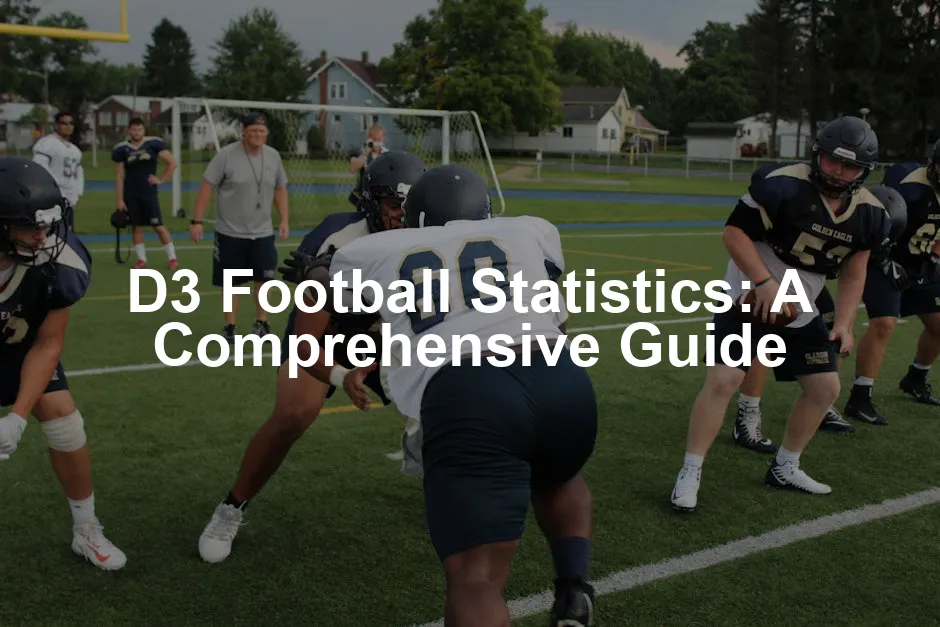Introduction
NCAA Division III Football is a treasure trove of talent. It’s where student-athletes shine, blending academics with athletics. Unlike its Division I counterpart, D3 emphasizes student participation over athletic scholarships. This unique structure allows for a more balanced experience. Fans can appreciate the game without the pressure of professional aspirations looming overhead.
Statistics play a crucial role in understanding this vibrant league. They provide insights into team strategies and individual performances. Want to know which player can throw a spiral like a pro? Or which team can stop the run like it’s nobody’s business? Statistics are your best friends. They help fans, analysts, and coaches dissect game performances and predict future outcomes.
This article aims to provide an in-depth look at D3 football statistics. You will learn how to leverage these stats. Whether you’re a die-hard fan, an analyst, or a coach, understanding these numbers can enhance your appreciation for the game. Let’s tackle the nuts and bolts of D3 football statistics, and how they can elevate your game-day experience!

Understanding D3 Football Statistics
What Are D3 Football Statistics?
D3 football statistics encompass a wide array of metrics. They track everything from individual player achievements to team performance. This includes passing yards, rushing attempts, points scored, and defensive stats like tackles and interceptions. These numbers give us a snapshot of how well a team or player performs over a season or a game.
So, how do D3 statistics differ from those in other divisions? The key lies in the emphasis on participation and education. In D3, the focus is less on flashy stats and more on the holistic development of athletes. While D1 might showcase players with jaw-dropping statistics paving their way to the NFL, D3 emphasizes teamwork, sportsmanship, and student success.
If you’re looking to dive deep into the world of football analytics, consider grabbing “Football Analytics: A Practical Guide”. This book will elevate your understanding of the game and help you appreciate the intricate strategies that teams employ.

Importance of Statistics in Football
Statistics are the backbone of game strategy. Coaches analyze numbers to tweak their game plans. Want to know when to blitz or when to drop back in coverage? The stats tell the story. They reveal trends, such as a team’s effectiveness on third downs or their defensive weaknesses.
Moreover, statistics keep fans engaged. They spark debates and create narratives throughout the season. “Did you see how many yards he threw for last week?” or “Our defense only allowed 150 rushing yards!” These conversations keep the spirit of competition alive and thriving.
In media coverage, stats are indispensable. Analysts rely on numbers to break down performances and highlight trends. Whether it’s a quarterback throwing for 400 yards or a defense allowing only three points, statistics are the foundation of the storytelling that surrounds D3 football.
By understanding and utilizing these statistics, fans, coaches, and analysts can appreciate the game on a deeper level, enhancing the experience for everyone involved. And speaking of deep appreciation, why not elevate your game with a stylish Wilson GST Leather Football? It’s perfect for practicing those passing skills!

Individual Player Statistics
Key Individual Statistics
In the realm of D3 football, individual player statistics are critical. They provide insights into performance and can sway the tides of games. Let’s break down some key individual statistics that fans and analysts track closely.
Passing Yards:
This stat measures the total yards a quarterback throws the ball. It’s a crucial indicator of a quarterback’s effectiveness. For example, as of October 18, 2024, Jacob Pugh from Wash. & Jeff. leads with 1,815 passing yards. He’s been slinging the ball like a pro, showcasing his ability to move the chains.
Rushing Yards:
Rushing yards track how many yards a player gains when running the ball. It’s a testament to a running back’s strength and agility. Brody Bantolina from Pacific (OR) tops this category with 844 rushing yards. His explosive speed and vision make him a nightmare for defenses.
Receiving Yards:
This stat counts the total yards gained by receivers after catching the ball. It reflects their ability to create separation and gain yardage after the catch. Players like Tyler Prather from Mt. St. Joseph, with 1,728 receiving yards, show just how essential they are in the offense.
Touchdowns:
Touchdowns are the gold standard in football. They represent the ultimate score, and players strive to rack them up. The more touchdowns a player has, the more valuable they become to their team.
Interceptions:
This statistic tracks the number of passes a quarterback throws that are caught by the opposing team. It’s a double-edged sword; while it can indicate a quarterback’s mistakes, it also highlights a defense’s tenacity.
Defensive Stats:
Defensive statistics, such as tackles and sacks, are vital in evaluating a player’s contribution to the defense. For instance, tackles represent the number of times a player brings down the opponent. Sacks are equally important, as they indicate a defense’s ability to pressure the quarterback.

Player Performance Metrics
Understanding how these statistics are calculated is essential. Passing yards are tallied every time a quarterback completes a pass. Rushing yards accumulate with each successful run. Receiving yards are determined by the distance gained after catching the ball.
For instance, Jacob Pugh’s impressive performance includes not just his passing yards but also his ability to read defenses and make quick decisions. Meanwhile, Brody Bantolina’s 844 rushing yards illustrate his ability to break tackles and find openings.
Examples of Top-Performing Players:
- Passing Leader: Jacob Pugh (Wash. & Jeff.) – 1,815 yards
- Rushing Leader: Brody Bantolina (Pacific OR) – 844 yards
- Receiving Leader: Tyler Prather (Mt. St. Joseph) – 1,728 yards
These statistics are not just numbers; they tell the story of each player’s season and highlight their contributions to their teams. And if you’re interested in coaching or improving your own skills, check out “Football for Dummies” for a comprehensive guide.

How to Interpret Individual Statistics
Interpreting individual statistics can feel like reading tea leaves at times. Averages, such as yards per game, provide a clearer picture. For example, if a quarterback averages 300 passing yards per game, they are likely a vital part of their team’s offensive strategy.
Consistency vs. Peak Performance:
Consistency is critical in football. A player who can deliver solid performances week after week can be more valuable than someone who has a few spectacular games. A quarterback throwing for 300 yards consistently has a different impact than one who throws for 400 yards one week and 150 the next.
On the other hand, peak performance can’t be overlooked. A player who can deliver a standout game when it matters most can turn the tide in critical moments.
In conclusion, understanding these statistics not only enhances your appreciation for the game but also provides insights into player capabilities and team dynamics. Whether you’re cheering from the stands or analyzing the stats, these numbers paint a vivid picture of D3 football talent and competition.

Team Statistics
Key Team Statistics
When it comes to D3 football, team statistics can be as dramatic as a last-minute touchdown. They tell us how a team scores, defends, and manages key moments in the game. Let’s break down some of the most important team statistics:
- Scoring Offense and Defense:
This is where the magic happens! Scoring offense measures how many points a team puts up on the board, while scoring defense indicates how many points the opposing team can score against them. For instance, as of mid-October 2024, UMass Dartmouth leads with a jaw-dropping average of 57.8 points per game. On the flip side, Hope College boasts a stifling defense, allowing just 6.4 points per game. Talk about a defensive wall! - Total Offense and Defense:
Total offense combines both passing and rushing yards to give a complete picture of how well a team moves the ball. Total defense does the same but focuses on how many yards a team allows opponents to gain. For example, Widener University shows off a total offense of 3,813 yards, which has helped them maintain a competitive edge. - Third Down Conversion Percentage:
This stat is crucial for assessing how well a team keeps its drives alive. It measures the percentage of successful conversions on third downs. Teams that excel here often control the game’s tempo. As of now, teams like North Central (IL) are shining with impressive conversion rates. - Penalty Statistics:
This is the unsung hero of team statistics. Fewer penalties often correlate with better performance. Teams that can avoid the yellow flags can maintain their rhythm, while those that rack up penalties can find themselves in a tight spot. For example, teams with the fewest penalties allowed this season include CWRU, which has maintained discipline on the field.
Team Performance Metrics
How do these statistics reflect a team’s capabilities? Well, a higher scoring offense often indicates a potent attack, while a lower scoring defense highlights a team’s resilience. Statistics reveal trends and help fans and analysts predict outcomes.
Current standings in October 2024 show that top teams like UMass Dartmouth and North Central (IL) are not just winning; they are doing so with style. Their offensive firepower coupled with strong defensive plays has made them formidable opponents.
Statistics also provide a foundation for analysis. For example, teams with high third-down conversion rates often maintain possession, leading to more scoring opportunities. A well-rounded team balances offense and defense, making statistics not just numbers but vital indicators of success.

Analyzing Team Statistics
Now, how can we assess a team’s strengths and weaknesses through these statistics? First, look at the scoring offense and defense. If a team scores high but allows numerous points, they might be involved in shootouts. Conversely, a team with a strong defense and a mediocre offense could struggle to win games.
Context is key! For instance, a team may have a poor scoring defense, but if they’ve faced the top offenses in the league, that stat might not tell the full story. Strength of schedule matters. Teams that dominate weaker opponents might not fare well against tougher competition.
In conclusion, analyzing these stats provides insights into a team’s overall capabilities. A comprehensive understanding of team statistics helps fans appreciate the game, while coaches can devise strategies based on what the numbers reveal. So, as you watch your favorite D3 teams, keep an eye on the stats; they might just reveal the secrets behind the scoreboard!

Advanced D3 Football Statistics
Emerging Trends in D3 Football Statistics
Advanced metrics are transforming how we understand D3 football. Gone are the days when basic stats sufficed. Now, we analyze efficiency ratings, yards after the catch, and more. These advanced metrics provide deeper insights into player and team performances.
Efficiency ratings help evaluate a player’s effectiveness. For instance, a quarterback’s rating takes into account not just passing yards, but also touchdowns and interceptions. This paints a fuller picture of their performance. Similarly, yards after catch (YAC) measures how much a receiver contributes after catching the ball. A player who can turn a short pass into a long gain can change the game’s momentum.
Data analytics is reshaping D3 football. Coaches and analysts use data to dissect game footage. They identify patterns that inform game strategy. For example, if a team excels in third-down conversions, expect them to rely on that strength. Conversely, if a squad struggles against the run, opponents will exploit that weakness.
The integration of stats is like adding spice to a dish. It elevates the game experience for players, coaches, and fans alike. No longer is it just about the score; it’s about how the teams achieved that score. As advanced metrics become more prevalent, we witness a shift in how teams prepare for games and how fans engage with the sport.

The Role of Technology in Statistics
Technology is the backbone of modern D3 football statistics. Tracking technology is revolutionizing how we gather player and team data. Devices placed on players collect real-time information on speed, distance, and even heart rate. This data allows teams to monitor player performance closely.
For instance, tracking technology can show how fast a running back reaches top speed. This insight helps coaches make informed decisions about player utilization. If a player consistently runs at high speeds during games, they might be ideal for plays requiring quick bursts of speed.
Advanced statistics also impact player recruitment. Scouts now focus on data-driven insights rather than relying solely on gut feelings. A prospect might excel in traditional measures, but if their data suggests they struggle in crucial game moments, teams will think twice. Metrics like completion percentage and yards per attempt offer a clearer view of a player’s potential.
Game strategy is also influenced by these advanced stats. Coaches analyze data to determine the best plays against specific opponents. If a team has a high average of yards gained on first downs, they might opt for riskier plays. Conversely, a team with a lackluster offensive record may resort to conservative strategies.
In essence, technology is the new playbook. It enhances how teams evaluate players and develop strategies. As we move forward, expect technology to play an even larger role. The future of D3 football statistics looks bright and data-driven. And while you’re at it, check out “The Football Coaching Bible” for insights on coaching strategies!

Case Studies and Examples
Statistical Analysis of Recent Games
Let’s take a look at a few recent high-stakes games that showcase the impact of statistics on outcomes and strategies. In a thrilling matchup on October 12, 2024, UMass Dartmouth faced off against North Central (IL). The game was a nail-biter, with UMass triumphing 45-42. Key statistics from this game revealed that UMass’s offense was firing on all cylinders, averaging 8.5 yards per play. Their ability to convert on third downs (65% success rate) proved crucial.
North Central, however, showcased resilience. They utilized a balanced attack, with both passing and rushing yards nearly equal. This strategy kept the UMass defense guessing, but ultimately, it was the UMass defense’s ability to force turnovers that tipped the scales. They recorded two interceptions, which led to 14 crucial points.
Another example is the clash between Hope and Kalamazoo on October 19, 2024. Hope emerged victorious with a commanding 49-18 win. The statistics tell the story: Hope’s defense held Kalamazoo to just 220 total yards, while they themselves racked up over 400 yards of offense. The disparity in yardage was evident, but it was their remarkable 4.5 yards per carry that truly defined the game. Hope’s offensive line dominated the line of scrimmage, allowing their running backs to thrive.
Statistics not only illustrate game outcomes, but they also inform coaching decisions. After analyzing the Hope vs. Kalamazoo game, coaches noted the effectiveness of their rushing attack. They’re likely to replicate this strategy in future games, emphasizing strong offensive line play.
In conclusion, recent D3 games underscore the importance of statistics. They influence strategies, highlight strengths, and reveal weaknesses. As we continue to analyze games through a statistical lens, we gain a richer understanding of the sport and its evolving dynamics. And if you’re curious about the history of the game, grab a copy of “Football: The First Hundred Years”.

Historical Context
D3 football statistics offer a fascinating glimpse into the evolution of the game. Over the years, trends in performance metrics reveal how the sport has shifted. Comparing current statistics with historical data shows us how teams and players have progressed. For instance, passing yards per game have seen a steady increase, reflecting a more open and dynamic style of play.
Notable performances in D3 football history stand out as statistical milestones. Take the legendary quarterback, North Central’s Broc Rutter, who set the NCAA record for passing yards in a season with 5,111 yards in 2018. His prowess not only redefined expectations for quarterbacks but also showcased the potential of D3 football. Such achievements inspire players and fans alike, reminding us that greatness knows no division.
Statistics like touchdowns scored and defensive stops highlight the importance of key moments. Each season, new records are set, and these performances add to the rich tapestry of D3 football lore. Understanding these statistics helps fans appreciate the legacy and current state of the game. And if you want to delve deeper into football tactics, consider “The Complete Guide to Football Tactics”.

Conclusion
Understanding D3 football statistics is crucial for several reasons. First, they provide valuable insights into team performance and player development. Coaches rely on these metrics to tailor training and game strategies. Fans, on the other hand, can enjoy a deeper appreciation of the game’s nuances.
Statistics illuminate patterns and trends, helping stakeholders make informed decisions. For instance, a team’s third-down conversion rate can signal its offensive efficiency. A high rate often correlates with winning, showcasing the importance of this stat. Coaches and players who focus on these details can enhance their game plan, leading to better outcomes on the field.
As D3 football continues to grow, so does the use of analytics. It’s not just about tracking yards and touchdowns anymore. Advanced metrics, like expected points added, are gaining traction. These allow for a more comprehensive assessment of performance. The future of D3 football statistics looks bright, with technology enhancing our understanding of the game.
Encouragement for fans, players, and coaches to embrace these statistics is essential. By analyzing data effectively, they can unlock new strategies and insights. Whether through game broadcasts or online databases, a wealth of information is available.
In conclusion, D3 football statistics are not merely numbers; they are the lifeblood of the game. They foster engagement, drive competition, and celebrate achievements. As we continue to embrace analytics, the stories behind the stats will only grow richer, adding depth to the game we all love. And if you’re looking for a great read on football history, “Football: The Game of Life” is a must-have. Check it out here.

FAQs
What are the most important statistics to follow in D3 football?
When it comes to D3 football, some key statistics stand out. Here are a few that fans should track: 1. Passing Yards: Measures a quarterback’s effectiveness and ability to move the ball. 2. Rushing Yards: Indicates a running back’s impact and ability to gain ground. 3. Touchdowns: The ultimate goal in any game, reflecting scoring proficiency. 4. Interceptions: Important for evaluating quarterback decision-making. 5. Total Defense: Captures how well a team prevents opponents from scoring. These metrics provide a solid foundation for understanding team and player performance.
How do D3 statistics compare to other divisions?
D3 football statistics differ from those in other NCAA divisions primarily in their focus. While Division I emphasizes individual accolades and high-profile performances, D3 highlights teamwork and participation. In D3, statistics serve to showcase collective efforts, often reflecting a more balanced approach to the game. For instance, teams in D3 may not have the same level of resources as D1 programs, influencing their statistical output. Thus, while the numbers might not be as flashy, they tell a story of grit and determination.
Where can I find up-to-date D3 football statistics?
For the latest D3 football statistics, several reliable sources are available. The NCAA website provides comprehensive data on individual and team stats. D3football.com is another excellent resource, offering detailed breakdowns and analysis of games and player performances. Both platforms are user-friendly and regularly updated, ensuring fans and analysts have access to current information.
How can statistics enhance a player’s performance?
Statistics play a pivotal role in enhancing a player’s performance. By understanding their metrics, players can identify strengths and weaknesses. For example, a quarterback can analyze their completion percentage to improve accuracy. A running back might focus on yards per carry to enhance decision-making during runs. Additionally, coaches can use statistics to tailor training regimens. By addressing specific areas for improvement, players can develop skills that translate into better on-field performance. Ultimately, a solid grasp of statistics empowers athletes to reach their full potential and contribute to their team’s success.
For a detailed look at team performance metrics, you can explore the france men’s national basketball team statistics.
Please let us know what you think about our content by leaving a comment down below!
Thank you for reading till here 🙂
All images from Pexels




